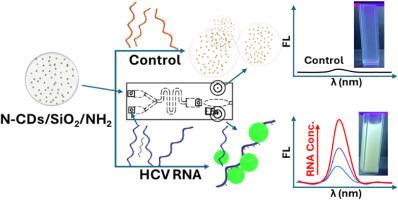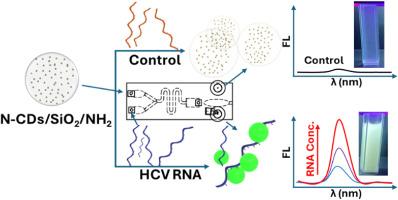基于微流控技术的嵌入式硅碳点荧光增强技术用于直接检测和量化临床样本中未扩增的 HCV RNA
IF 5.7
2区 化学
Q1 CHEMISTRY, ANALYTICAL
引用次数: 0
摘要
背景丙型肝炎病毒(HCV)是一种无症状慢性感染,具有严重的临床后果。及时灵敏地检测 HCV RNA 对于感染控制、治疗反应跟踪至关重要。尽管目前的技术,如基于 PCR 或等温扩增的策略,具有特异性,但它们价格昂贵、劳动强度大、耗时长,限制了它们在野外和小型实验室的使用。这种方法利用了交联增强发射(CEE)现象,将荧光氨基功能化的二氧化硅涂层氮掺杂碳点(N-CDs/SiO2/NH2)与磁性提取的未扩增 HCV RNA 混合后,荧光立即显著增强。这种方法被集成到半自动三维打印微流控芯片中,将未扩增的 RNA 与 N-CDs/SiO2/NH2 混合。该检测方法还被用于传统的 96 孔板格式。该检测方法灵敏度高,芯片和孔板的检测限分别为 500 IU/ml 和 1000 IU/ml。在芯片上,样本到结果的时间为 20 分钟,比基于扩增的技术更简单。通过分析 141 份患者样本,灵敏度和特异性分别达到 96.47 % 和 98.79 %。意义首次将 N-CDs/SiO2 用作核酸荧光探针,为核酸检测提供了一个多功能、经济高效的通用平台。所开发的系统可用于传统的微孔板检测,只需对当前的实验室设置进行最小限度的修改。此外,它还被集成到 3D 打印微流控芯片中,从而提高了特异性、灵敏度和准确性。本文章由计算机程序翻译,如有差异,请以英文原文为准。


Microfluidic-based fluorescence enhancement of silica-embedded carbon dots for direct detection and quantification of unamplified HCV RNA in clinical samples
Background
Hepatitis C Virus (HCV) is an asymptomatic chronic infection with serious clinical consequences. Timely and sensitive detection of HCV RNA is critical for infection control, treatment response follow up. While current technologies, such as PCR or isothermal amplification-based strategies, are specific, they are expensive, labor intensive, time consuming limiting their use in field and small laboratories.
Results
We introduce a novel technology for detecting nucleic acids, as exemplified by HCV RNA, in clinical specimens. This approach utilizes the crosslinked Enhanced Emission (CEE) phenomena upon mixing fluorescent amino functionalized silica-coated nitrogen-doped carbon dots (N-CDs/SiO2/NH2) with magnetic extracted unamplified HCV RNA showed a significant and immediate fluorescence enhancement. This method was integrated into a semi-automated 3D printed microfluidic chip, wherein the unamplified RNA was mixed with the N-CDs/SiO2/NH2. The assay was also employed on the conventional 96-well plate format. This assay offers high sensitivity with detection limit of 500 IU/ml and 1000 IU/ml for the chip and well plate respectively. The sample-to-result time was <20 min on the chip and is simpler than the amplification-based techniques. Analyzing 141 patient samples yielded sensitivity and specificity of 96.47 % and 98.79 % respectively.
Significance
This application of N-CDs/SiO2 as nucleic acid fluorescent probes for the first time, offers a versatile, cost-effective, and universal platform for nucleic acids detection. The developed system can be employed in conventional microwell plate-based detection with minimal modifications to current laboratory setups. Additionally, it was integrated into a 3D-printed microfluidic chip enabling enhancement in specificity, sensitivity and accuracy.
求助全文
通过发布文献求助,成功后即可免费获取论文全文。
去求助
来源期刊

Analytica Chimica Acta
化学-分析化学
CiteScore
10.40
自引率
6.50%
发文量
1081
审稿时长
38 days
期刊介绍:
Analytica Chimica Acta has an open access mirror journal Analytica Chimica Acta: X, sharing the same aims and scope, editorial team, submission system and rigorous peer review.
Analytica Chimica Acta provides a forum for the rapid publication of original research, and critical, comprehensive reviews dealing with all aspects of fundamental and applied modern analytical chemistry. The journal welcomes the submission of research papers which report studies concerning the development of new and significant analytical methodologies. In determining the suitability of submitted articles for publication, particular scrutiny will be placed on the degree of novelty and impact of the research and the extent to which it adds to the existing body of knowledge in analytical chemistry.
 求助内容:
求助内容: 应助结果提醒方式:
应助结果提醒方式:


